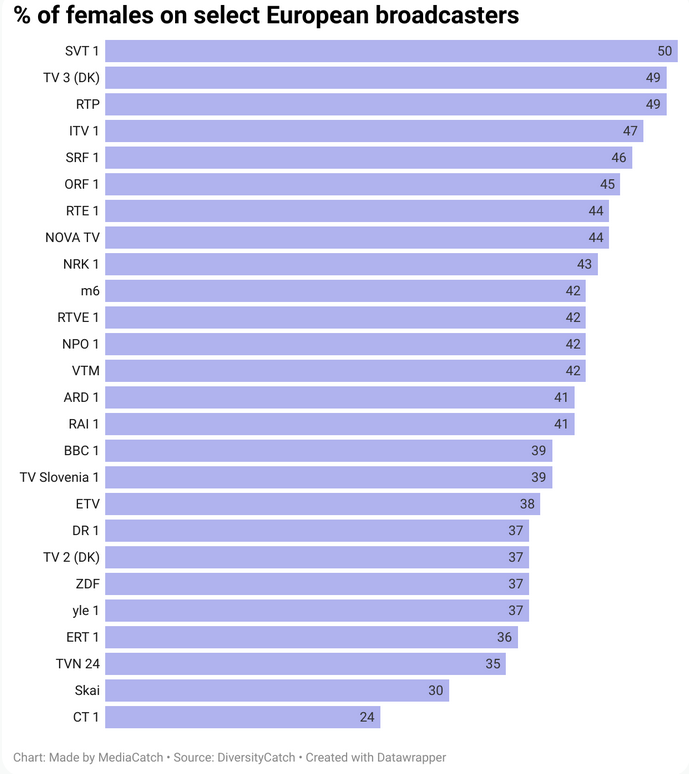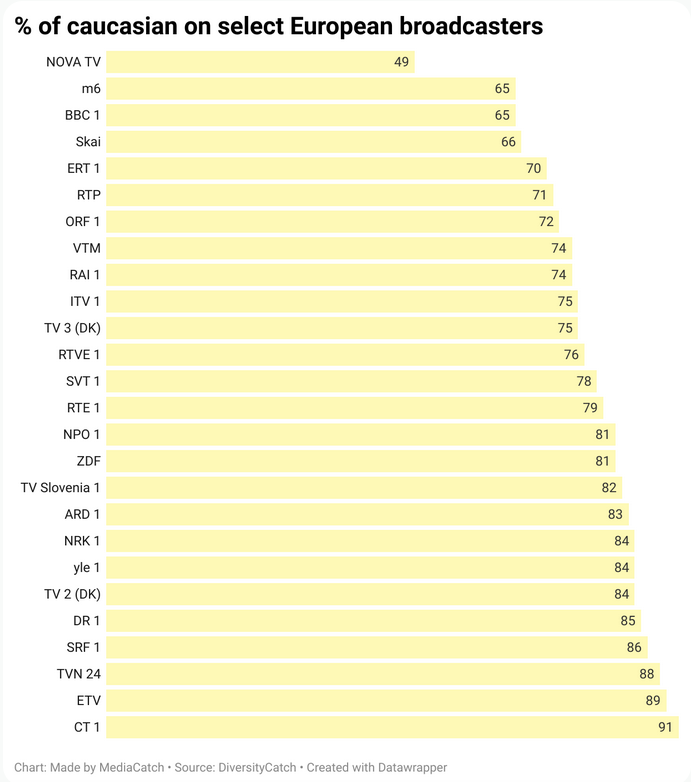
Rear view of the BBC's newsroom studio in Broadcasting House, London.
Credit: Michal Bělka via Creative CommonsLars Damgaard Nielsen is CEO and co-founder of MediaCatch, an audio and video media intelligence and research company. He is also formerly a lecturer at the University of Southern Denmark and head of social media at Danish public broadcaster DR.
Media representation plays a vital role in shaping social attitudes and contributing to the discourse around diversity and inclusivity.

MediaCatch's recent Diversity Index of European Broadcasters' Content report has illuminated the stark underrepresentation of women and ethnic minorities in the European media landscape.
The analysis, based on the employment of artificial intelligence, is groundbreaking for its extensive scale, involving broadcasters across 21 countries and over 13,500 hours of content over two weeks in May and the first week of June 2023.
Everything a broadcaster has aired we have analysed - not only the journalists and hosts, but the guests, too. We use facial recognition to estimate a person's age within a range of +/-4 years. Origin identification is 90 per cent accurate and gender identification is 98 per cent accurate. Note, we cannot measure transgender. Our gender recognition is binary.
For instance, women account for nearly a third (39 per cent) of on-screen faces at the BBC and half (47 per cent) on ITV.

Rather than being merely a pinprick sample of specific programs - which is the normal way to count diversity - AI makes it possible to encompass everything that is broadcasted. Furthermore, it spans across various genres and programmes.
The mirror is broken
Public service broadcasters are mandated to serve as mirrors to society, reflecting the diverse lived realities of the populations they represent.
This disconnect compromises the ability of public broadcasters to act as the cohesive force they are meant to be. It undermines their credibility and relevance to a large segment of the society they are tasked with representing.
That is problematic because, for public service broadcasters, it is their reason for existence. If the mirror is broken, its raison d'être for the public broadcasters is too.
Europe is divided
Commercially, it is increasingly evident that diversity in content can enhance viewer engagement, driving both ratings and revenues. By presenting a broader array of narratives that are more reflective of societal realities, broadcasters can attract and retain more substantial and diverse audience segments.
Higher viewership translates directly to higher advertising revenue and greater potential for international content sales. Evidence also suggests that diverse companies tend to be more innovative and resilient, better equipped to navigate change and sustain growth.
Look deeper at our data and notice stark differences between countries regarding representation, underscoring the issue's complexity.
Sweden and Portugal emerged as leaders in terms of gender parity, providing models for other countries to emulate. These variances suggest that there are concrete steps broadcasters can take to improve representation.
Some of the countries that could rise to the challenge and attempt to resolve their representation issue are Greece and The Czech Republic. Three quarters (76 per cent) of screen time is afforded to men which is deeply unfair.
There is also age and racial background to consider.

So who is talking about football?
It is also possible to use speech-to-text and gender-voice recognition to measure what people are talking about.
Parity of on-screen representation is one thing; parity in the topics spoken about is another. What we see in our clients is a sad fact that if programmes are equal in gender, they tend to be very not equal in the topics. Guess who is talking about football.
Where do we go from here?
These implications are not just societal, affecting the credibility and relevance of public service broadcasters, but also commercial, influencing viewer engagement and revenue generation.
Addressing this issue will require a multi-pronged approach, involving in-depth, ongoing analysis of content diversity and the development of comprehensive strategies to improve representation across the board.
By doing so, broadcasters can fulfill their mandate to represent their diverse audiences accurately, enhance their societal impact, and unlock significant commercial benefits.
Free daily newsletter
If you like our news and feature articles, you can sign up to receive our free daily (Mon-Fri) email newsletter (mobile friendly).
Related articles
- Nine AI hacks for newsroom leaders to promote employee wellbeing
- Recruiting for inclusion: a guide for media organisations
- Why video journalism is not ready to ditch its editors
- Who to follow: 27 women covering the independent publishing sector
- RISJ Digital News Report 2024: Three essential points for your newsroom









